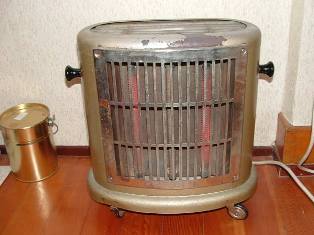Opening of the thermal current action
Among the thermal effects produced by the battery current, the most visible, without a doubt, was an arc between two carbon conductors. Already in 1802, Kurten said that at the time of the battery the circuit with an iron wire in contact with a piece of charcoal, there were sparks are so bright that they lit up the surrounding objects. A few years later, John Children {1778-1852) discovered that some pieces of charcoal placed in the chain, "spread the light so bright that even the solar disk glow seemed weak compared to him."

But the truly spectacular phenomenon demonstrated in 1810 Davie using a large battery, consisting of 2,000 items and they built at the expense of the Royal Institute. Apart from the various experiments on the rapid and incandescent molten metal, which he hit the audience at his first lecture, held after the construction of this colossal batteries Devi also had experience with long pieces of coal with an inch thick, and the sixth of an inch, included in the battery circuit. After the circuit was closed, he slipped brightest spark and lumps of coal were heated white hot by more than half of its length, "... when the two pieces of carbon steel removed from each other, formed a continuous discharge through a hot air at a distance of at least four inches wide as unusually bright arc conical convexity facing upwards. "
Davy immediately checked how high the temperature of the arc, which melts platinum, "as if it was a wax candle flame." The arc length can be increased by placing it under a cap pneumatic machine and cut the air, and if the sparsity was strong enough, managed to obtain an arc very showy purple in six or seven inches long.
It is clear that the experience of Davie, whose powerful battery needed, it was not easy to repeat. Therefore, when ten years later, in July 1820, De la Riva managed to repeat this experience in front of the Geneva scientific societies, it seemed a thing so new that until today some historians attribute this discovery Geneva physics.
If the experience of the arc hit its spectacular nature, the other thermal phenomena seem very confusing. So spending on the advice of Wollaston experience with two platinum wires, Children (1815) found that of the two platinum wires of the same length but different diameters are connected in series, it glowed only thinner, while in parallel operation only glowed more thick. Davey (1821), heating the bulb part of the chain, sought to reduce the temperature of the other part, and cooling it with ice, the resulting increase in the temperature of the other.

Up until 1841, all attempts to explain these and many other strange phenomena proved unfounded, but strengthens the view that the heating conductors is associated with resistance, they have current flowing through them, so that greater resistance corresponds to more heat. This opinion was expressed even Kinnersley on the heat generated by the discharge of a Leyden jar. Based on the experiments mentioned above, Davy went further, stating that "... the conducting ability of metal varies with changes in temperature and decreases in the same ratio, in which the temperature increases."
This law is now well known, much less know who opened it.
Mario Letstsi "History of Physics"


Comments
Commenting, keep in mind that the content and the tone of your messages can hurt the feelings of real people, show respect and tolerance to his interlocutors, even if you do not share their opinion, your behavior in terms of freedom of speech and anonymity offered by the Internet, is changing not only virtual, but real world. All comments are hidden from the index, spam control.